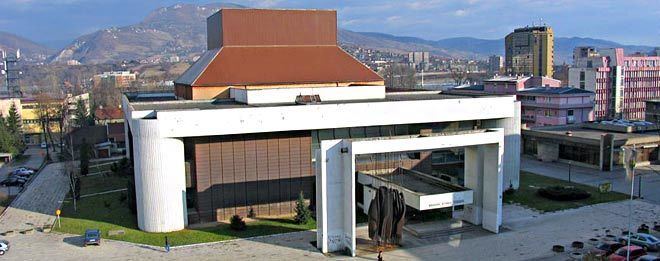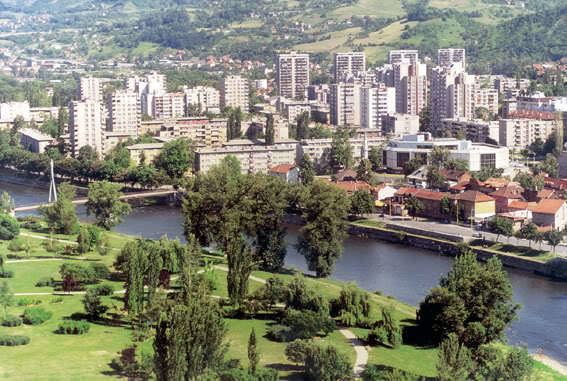Country University University of Zenica | Population 145,517 (1991) Area 558.5 km2 | |
 | ||
Map of Zenica
Zenica ([zɛ̂nitsa]) is the fourth-largest city in Bosnia and Herzegovina, and the capital of the Zenica-Doboj Canton of the Federation of Bosnia and Herzegovina entity. Zenica is located about 70 km (43 mi) north of Sarajevo and is situated on the Bosna river, surrounded by a mountainous and hilly landscape. The city is home to 115,134 inhabitants as of 2013.
Contents
- Map of Zenica
- Ancient history
- Medieval
- Ottoman Empire
- Austro Hungarian Empire
- Yugoslavia
- Bosnian War
- Geography
- Transport
- Twin cities
- Notable people
- References

Zenica was an important economic and military center during the Banate of Bosnia and the Kingdom of Bosnia, and one of the relics from these eras is the Vranduk fortress. The city's old quarter contains several attractions, including the former synagogue, dating from 1906, which is now part of the City Museum. There is also a mosque, an Austrian fountain and an old bey's farm house (Hadžimazića Kuća).
Ancient history
The urban part of today's Zenica was formed during several specific periods which can be chronologically dated to the time of Neolithic community, Illyrian old towns ruins, Roman Municipium Bistua Nova, and the most important archaeological finding; an early Christian double basilica dating from the 2nd to 4th century, one of two that have so far been identified in Europe. Ruins of a substantial ancient settlement were found not far from Bilimišće (a suburb on the south side of the town) and close by the villages of Putovići and Tišina, with sites like a Villa Rustica, baths, pagan temples among other structures.
Medieval
Known by the Romans as Bistua Nova, the town became known as Bilino Polje (Bilin's Field), Brod and finally took its modern name of Zenica from 20 March 1436. During the Middle Ages, the town was important in the governance of the Bosnian Kingdom, in particular under Ban Kulin in the 12th Century. Nearby were the stone fortress of Vranduk, the residence of the Kings of Bosnia at Bobovac and the village of Janjici, where the Did, head of the Bosnian Church resided. The nearby villages of Puhovac and Pojske are the site of several Stećak tombstones, unique to Bosnia and Herzegovina and parts of Croatia, Montenegro and Serbia.
Ottoman Empire
During the rule of the Ottoman Empire (1463–1878), changes to the main trade routes sidelined the town in Bosnian affairs, except during a brief period until 1557, when Zenica was the residence of the Ottoman Qadi of Brod. Zenica became a small town with several mosques: Sultan Ahmet's, Osman Chelebi's, Seymen and Jali mosques, a Madrassa (Islamic religious school), founded in 1737 and several lower primary schools, with interesting Ottoman tombstones, gardens, inns and several stopping inns for caravans.
In one description from the year 1697, Zenica is compared to a delta of the Nile, where melons grow and where the entire landscape is very pleasant. It is estimated that Zenica had 2,000 inhabitants at that time; mostly Muslims, although Catholics and Orthodox Christians are mentioned in documents at the end of the 18th century and, during the 19th century, sizable communities of Jews are also mentioned.
The raids of Eugene of Savoy during the Great Turkish War during the 1680s are remembered as dark times which left a lot destruction and caused an exodus of population, but by 1697, Zenica had started to stabilise and to begin to recover its influential position.
Austro-Hungarian Empire
At the end of the 19th century, during the Austro-Hungarian occupation of Bosnia and Herzegovina, there were investments in capital projects that had wider social and economic importance, and were soon to become life and fate of Zenica. Those projects include a railway from Bosanski Brod to Zenica built in 1879, a coal mine (1880), paper works (1885), steel factory (1892), and a prison (1886).
In the beginning of the 20th century, there was an urban boom and the official State Register for the year 1910 shows that in only a few years the number of population had increased to 7,215 inhabitants. An Orthodox Church was built in 1882, two Roman Catholic churches in 1910, a synagogue in 1903, several coaching inns, a hotel, a school, sewerage, paved roads and more. The city changed markedly in character during this period as might be expected during such a developmental boom.
Yugoslavia
During the Second World War, the local population (predominantly Muslim) signed the Resolution of the Muslims of Zenica in May 1942, and formed Muslim militias in the villages of Šerići, Doglodima, Babino and other places who joined the Yugoslav Partisans. Zenica managed to escape major physical damage or large-scale reprisals and human casualties.
Following the liberation of Zenica by the Partisans in 1945, the town began to grow rapidly as the steel industry developed further. The town spread to encompass the former villages of Bilino Polje, Klopce and Radakovo, and new apartment blocks were built to house the new miners and steelworkers. In 1948 the population was only 12,000 people, but by 1961 it had grown to over 30,000. In 1981 the town had over 63,000 people, and in the last census taken 1991 Zenica was a city of some 96,027 people. The city has seen a sixfold increase in its population over 50 years.
Bosnian War
In 1991, the year before the Bosnian War began, Zenica became the headquarters of one of the first private and independent radio stations in Eastern Europe, Radio CD-CEMP. In the spring of 1993, Zoran Mišetić, a journalist and owner of Radio CD-CEMP, was granted the Belgian Award for Independent Journalism, known as The Pen Of Peace.
On 19 April 1993, during the Croat-Bosniak War, 15 civilians were killed and 50 others injured, when a HVO Howitzer grenade landed in the central market place of Zenica. The grenade was fired from the village of Puticevo (15 kilometers from Zenica). A total of six grenades landed, in rounds of three. One round of two at 12.10 pm, one round of two shells at 12.24 pm, and a further round of two shells at 12.29 pm. During this period Zenica was isolated from the rest of the world for a year and a half. The city suffered considerable civilian casualties from sniper fire, firefights and hunger. Bosnia's fourth-largest city had no water or electricity.
During the war, the demographics of the city were altered by an influx of ethnic Bosniak refugees from other parts of Bosnia, while the Serb population left for parts of Serb-controlled Bosnia. One of the biggest steel mills in South Central Europe has been privatized and now bears the name of the Mittal Steel Corp.
Geography
Zenica is situated in the middle part of the River Bosna from which the country takes its name, and stands at 316 meters (1,037 ft) above sea level. The source of the River Bosna is in Ilidža near Sarajevo and the confluence with the River Sava is near Bosanski Šamac, which makes the river a natural north-south axis. The Zenica valley itself stretches from Lasva canyon in the south to Vranduk canyon to the north.
Transport
Zenica is connected with Sarajevo (70 kilometres (40 mi) to the southeast), by rail and road, both of which run along the valley of the river Bosna. The A1 motorway connects Zenica with Sarajevo and Mostar. The closest airport is Sarajevo International Airport. The railway line continues to the south, eventually reaching the coast at Ploče in Croatia.
